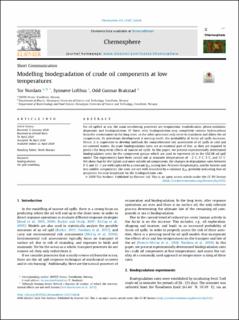Modelling biodegradation of crude oil components at low temperatures
| dc.contributor.author | Nordam, Tor | |
| dc.contributor.author | Lofthus, Synnøve | |
| dc.contributor.author | Brakstad, Odd Gunnar | |
| dc.date.accessioned | 2020-09-08T08:53:27Z | |
| dc.date.available | 2020-09-08T08:53:27Z | |
| dc.date.created | 2020-04-30T08:32:31Z | |
| dc.date.issued | 2020-09 | |
| dc.identifier.citation | Chemosphere. 2020, 254 126836. | en_US |
| dc.identifier.issn | 0045-6535 | |
| dc.identifier.uri | https://hdl.handle.net/11250/2676811 | |
| dc.description.abstract | For oil spilled at sea, the main weathering processes are evaporation, emulsification, photo-oxidation, dispersion and biodegradation. Of these, only biodegradation may completely remove hydrocarbons from the environment in the long term, as the other processes only serve to transform and dilute the oil components. As petroleum development is moving north, the probability of Arctic oil spills increases. Hence, it is imperative to develop methods for comprehensive risk assessment of oil spills in cold and ice-covered waters. Accurate biodegradation rates are an essential part of this, as they are required to predict the long-term effects of marine oil spills. In this paper, we present experimentally determined biodegradation rates for the component groups which are used to represent oil in the OSCAR oil spill model. The experiments have been carried out at seawater temperatures of , , , and . We show that for the lighter and more soluble oil components, the changes in degradation rates between and are well captured by a constant scaling law. At lower temperatures, and for heavier and less soluble components, the rates are not well described by a constant , probably indicating that oil properties become important for the biodegradation rate. | en_US |
| dc.language.iso | eng | en_US |
| dc.rights | Navngivelse 4.0 Internasjonal | * |
| dc.rights.uri | http://creativecommons.org/licenses/by/4.0/deed.no | * |
| dc.subject | biodegradation | en_US |
| dc.title | Modelling biodegradation of crude oil components at low temperatures | en_US |
| dc.type | Others | en_US |
| dc.description.version | publishedVersion | en_US |
| dc.rights.holder | © 2020 The Authors. Published by Elsevier Ltd. | en_US |
| dc.source.pagenumber | 126836 | en_US |
| dc.source.volume | 254 | en_US |
| dc.source.journal | Chemosphere | en_US |
| dc.identifier.doi | https://doi.org/10.1016/j.chemosphere.2020.126836 | |
| dc.identifier.cristin | 1808751 | |
| dc.relation.project | Norges forskningsråd: 255385 | en_US |
| cristin.ispublished | true | |
| cristin.fulltext | original | |
| cristin.qualitycode | 1 |
Tilhørende fil(er)
Denne innførselen finnes i følgende samling(er)
-
Publikasjoner fra CRIStin - SINTEF Ocean [1387]
-
SINTEF Ocean [1461]

